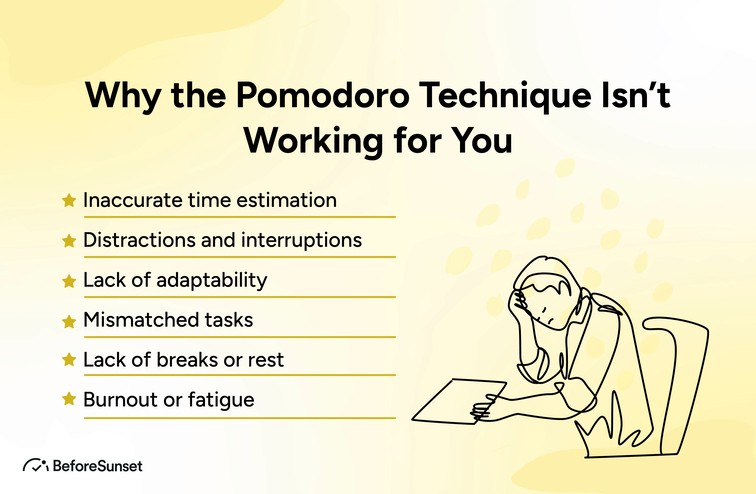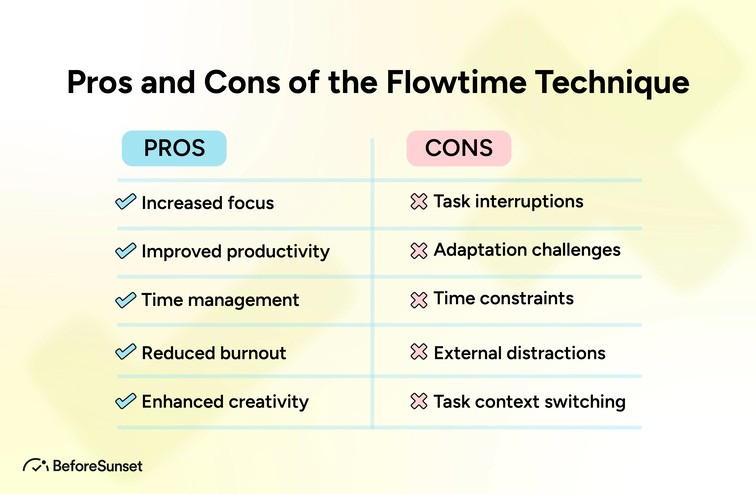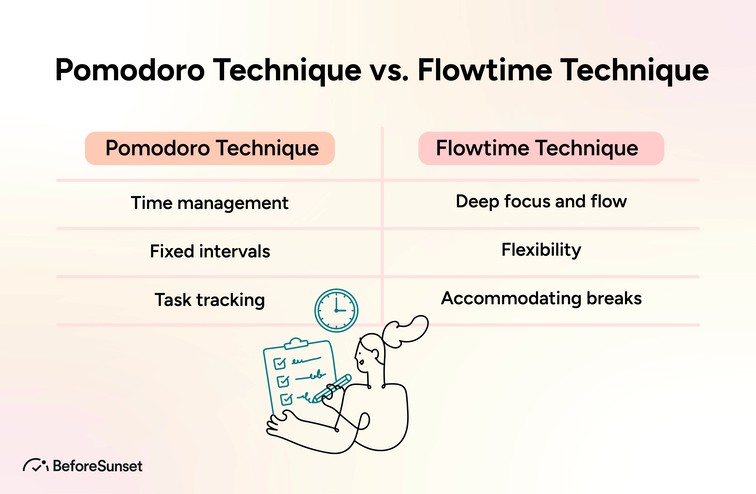“If you need a 10-minute break after working for 40 minutes, that’s fine. Refreshed work is orders of magnitude better than fatigued work.”
Zoe Read-Bivens
Flowtime is a simple concept that encourages you to focus on the tasks at hand without getting distracted. The concept is based around your day flowing as easily as possible with less work interruption. We're going to discuss how you can use Flowtime to boost your productivity using ideas and input from the Pomodoro technique.
What Is the Flowtime Technique?
The Flowtime Technique is a method of improving your focus, productivity, and well-being by training your brain to be present in the moment. It was developed by Zoe Read-Bivens to help people stop getting distracted and stressed out by the little tasks that can get in the way of big-picture thinking.
The Flowtime Technique is based on the idea that if you're able to focus on what you need to do right now, without being pulled away by other thoughts or distractions, you'll be able to accomplish more than ever before.
When most people try to focus on one task at a time, they don't really succeed—they end up spending all their time switching between tasks. By using the Flowtime Technique, though, you can train your brain not to distract itself with other things until it's finished what it needs to do now.
A Step-by-step Guide to the Flowtime Technique
Flowtime is an amazing technique that can help you to connect with yourself, your goals and your purpose—and it's actually pretty simple.
1. Pick a time of day when you're usually at your best. Maybe that's early in the morning, or maybe it's right after lunch—it doesn't matter when it is as long as it works for you.
2. Set aside 15 minutes to do nothing but focus on yourself and your intentions. If you need to, set an alarm on your phone as a reminder to make sure you don't forget about this time during the day!
3. Once the 15 minutes are up, take a few moments to reflect on how things went—what worked well? What didn't work so much? How can you adjust things next time? If necessary, write down any ideas or insights that came up during this exercise so that they don't get lost!
What Is the Pomodoro Technique?
Francesco Cirillo created the Pomodoro Technique as a time-management technique in the late 1980s. Pomodoro, which means tomato in Italian, was the name of the kitchen timer that Cirillo used to keep track of his work intervals. By segmenting work into brief, concentrated periods known as "pomodoros" and interspersing them with frequent breaks, the approach seeks to increase concentration and productivity.
Here is a broad explanation of the Pomodoro Technique's operation:
Select a task: Choose a specific project or job that you wish to work on.
Start a timer: Start a timer for a predetermined amount of time, often 25 minutes, or one "pomodoro."
Work on the task: During the pomodoro, give your full attention to the chosen activity, putting aside all other activities and concentrating as hard as you can.
Take a break: Take a short rest of around five minutes after the timer sounds. You're able to relax and recover during this interval.
Repeat and keep track: Begin another pomodoro and carry on the cycle after the break. Take a longer pause of 15 to 30 minutes after doing four pomodoros.
The goal is to work in concentrated bursts of time, which can help people stay motivated, avoid burnout, and increase productivity in general. Before starting the next pomodoro, the regular pauses provide time to relax, think, and refuel.
Although the standard pomodoro time is 25 minutes, you may change the intervals according to your preferences and the type of work you're doing. For jobs that call for concentration, including learning, writing, programming, or other concentrated work, many people find the method to be effective.
There are several online resources and smartphone applications that may help you with Pomodoro time, making it simpler to keep track of and manage your work sessions.
Always keep in mind that you may modify the Pomodoro Technique to fit your goals and workflow.


Pros and Cons of the Flowtime Technique
Flowtime is the new wave of time management, designed to help you work smarter rather than harder. But before I get into details, let me first clear up a few things: what is flow? How can we use flow in our day-to-day lives? What are the pros and cons of flow, and what are some alternatives?
Advantages of the Flowtime Technique
You're probably wondering what the Flowtime Technique is. It's a new way of working that's helping people around the globe feel more productive, more focused, and more energized than ever before.
Here are just some of the benefits you can expect to experience when you try Flowtime:
Increased Productivity: The Flowtime Technique has been shown to increase productivity by up to 20%, without increasing stress levels.
Better Health: The technique helps you relax and stay healthy, even if you have a stressful job or a busy schedule.
More Focused Work: You'll be able to focus on the task at hand without being distracted by other things that may be on your mind—making it easier for you to get things done quickly and efficiently.
Disadvantages of the Flowtime Technique
The Flowtime Technique is a very good method of managing your time, but it has some drawbacks.
It can be hard to get used to because it is different from the way most people manage their time. You will have to learn new habits and routines, and you may find yourself forgetting what you are doing as you get into the flow.
The Flowtime Technique requires a lot of discipline and self-control. If you are not disciplined, you will probably not succeed in using this technique effectively.
How to Make the Most Out of the Flowtime Technique
The flowtime technique is one of the most effective ways to manage your time and get things done. This guide will show you how to make the most out of this great productivity tool.
First, you'll need to understand what flowtime is. The basic idea is that time passes differently for each person, but when you're in "the flow," it feels like time is passing by quickly. That's why it's called "flowtime."
The next step is to use the flowtime technique. This means setting aside a specific amount of time for a task or project, and then working on it until it's finished or until the timer runs out and you need to take a break.
Finally, repeat these steps over and over again until your entire project has been completed!

Pomodoro Technique vs. Flowtime Technique
The Pomodoro Technique and the Flowtime Technique are two ways to improve your productivity. Both techniques involve setting a timer and focusing on one task, but each has its own approach.
The Pomodoro Technique uses a timer that divides time into intervals of 25 minutes each, separated by short breaks. The Flowtime Technique uses three timers to divide up time into intervals of 15 minutes each, with longer breaks at the end of each interval.
Both techniques can help you eliminate distractions and focus on a single task for an extended period of time. However, many people prefer one method over the other because it works better with their personality or lifestyle.
How Do You Know You Need to Take a Break?
Knowing when to take a break is a crucial ability for preserving productivity and wellbeing. You can use the following cues to determine whether a break is necessary:
Mental fatigue: If you're feeling mentally exhausted, having trouble focusing, or losing focus, your cognitive resources may be running low. This can be a sign that you need to take a break to refresh your mind.
Physical pain: When you experience physical discomfort, such as headaches, eye strain, muscular tightness, or general restlessness, your body is telling you that it needs a break. Taking brief breaks might assist to ease the effects that prolonged sitting or repeated chores can have on your physical health.
Reduced productivity: If you observe a major dip in your output or a deterioration in the quality of your work, this might be an indication that your brain is struggling to function at its best due to exhaustion. Taking a break from the activity at hand might give you a new perspective and improve your problem-solving skills.
Lack of motivation or boredom: Lack of interest or boredom: If you find yourself getting bored with what you're doing, daydreaming a lot, or lacking the drive to keep going, it could be time for a break. Breaks might help you regain your motivation and renew your excitement.
Distractions and an increase in mistakes: It's a sign that your attention may be diminishing if you find it difficult to stay focused and you start making more blunders. When you come back to the work, taking a break might help you regain your attention and increase your accuracy.
Feeling pressured or overwhelmed: It's important to recognize these symptoms as signals that you need to take a break and look after yourself if you're feeling particularly stressed, overwhelmed, or anxious. Breaks can give you a chance to unwind, decompress, and restore your composure.
Keep in mind that everyone has distinct break requirements and boundaries. It's crucial to pay attention to your body and mind and to your personal wellbeing. In the long term, taking frequent, restorative breaks can actually improve output, creativity, and performance.

